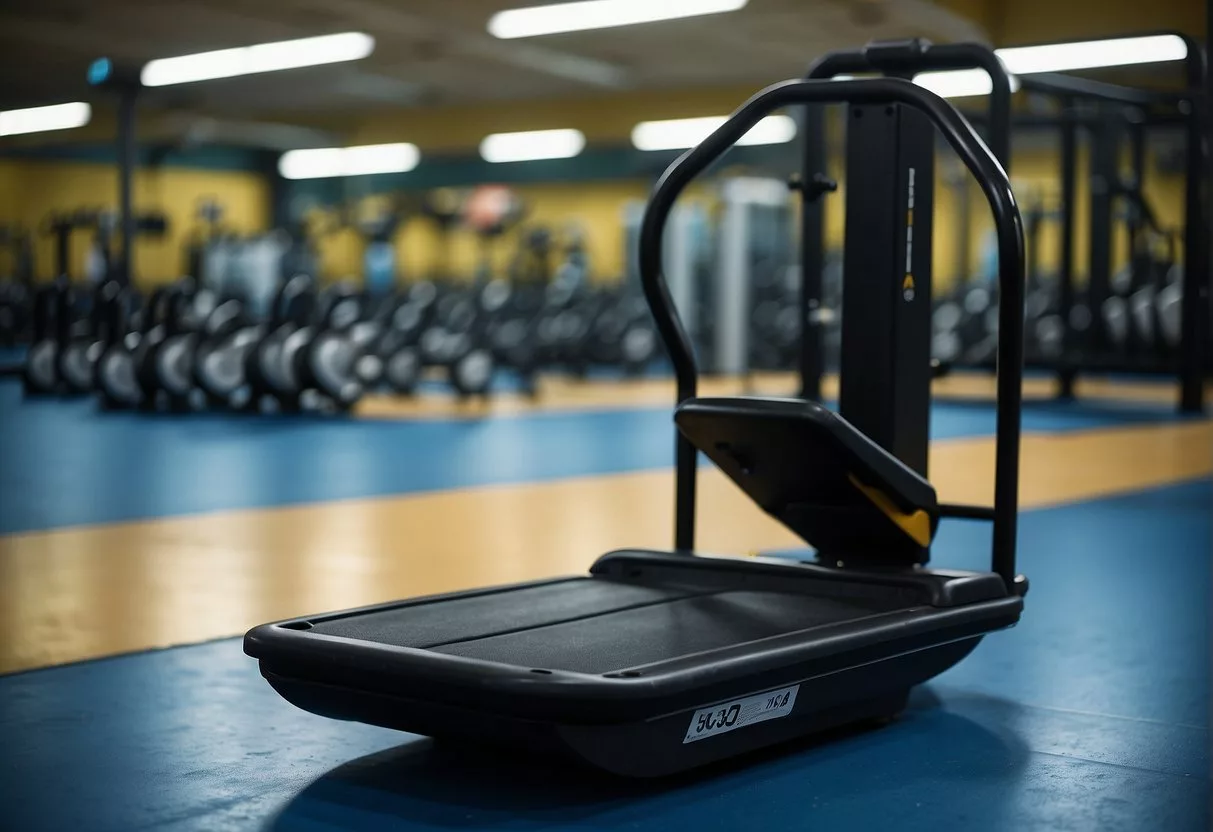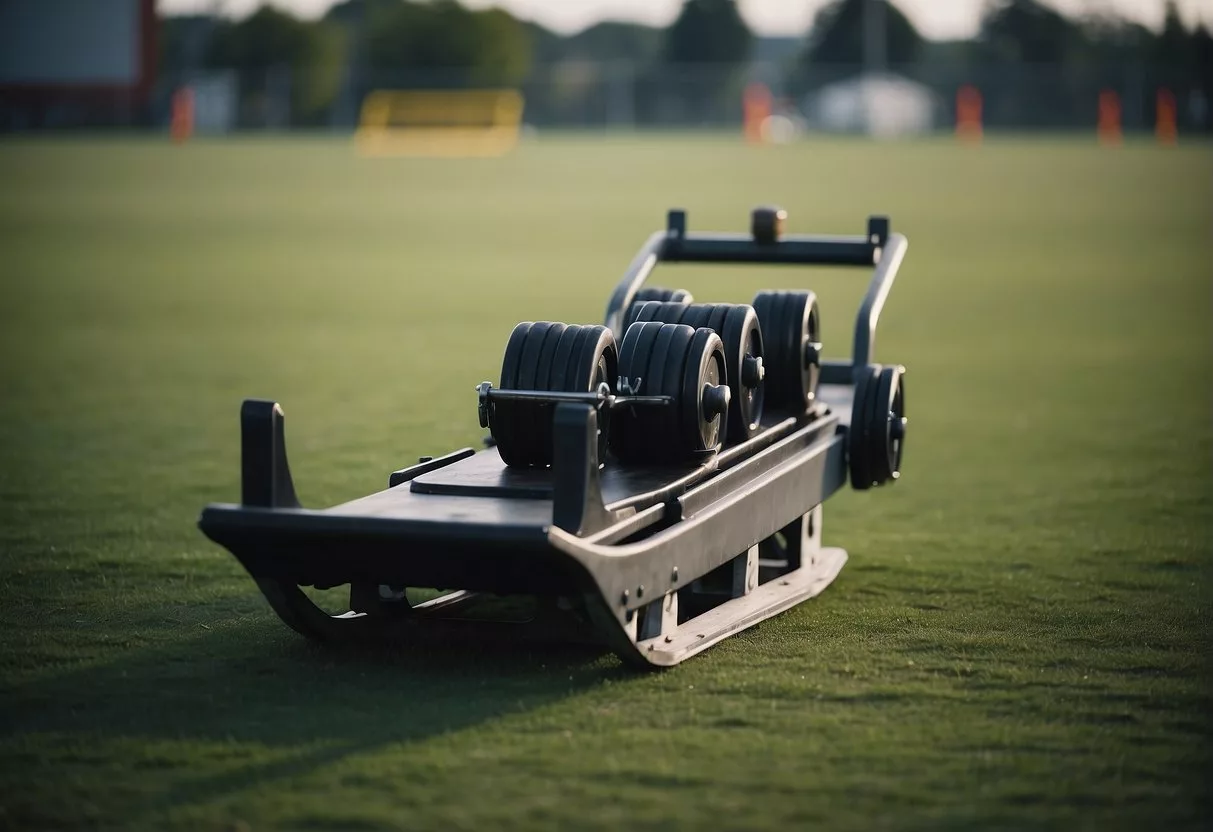Sled pushing workouts are gaining popularity as an effective method for improving overall fitness. Characterized by the action of pushing a weighted sled across a flat surface, this high-intensity exercise requires the recruitment of major muscle groups. It doesn’t just target the lower body muscles like quads, glutes, and hamstrings, but also engages the core, triceps, and shoulders. The versatility of sled pushes allows them to be incorporated into various training programs for athletes of all levels.
The attraction to sled push workouts stems from their ability to build power, speed, and endurance without putting excessive strain on the lower back—something that traditional squats and deadlifts can sometimes do. This type of workout is scalable, meaning it can be adjusted to fit individual fitness levels whether one is new to exercise or an experienced athlete looking to enhance performance. Additionally, its simplicity makes sled pushing easy to learn with the correct technique, yet challenging enough to stimulate adaptation and improvement over time.
Key Takeaways
- Sled pushing workouts engage major muscle groups and can enhance power, speed, and endurance.
- They are scalable to all fitness levels and do not excessively strain the lower back.
- The workouts are simple to learn and can be progressively challenging for continued improvement.
Benefits of Sled Pushing Workouts

Sled pushing workouts offer a range of physiological enhancements that can significantly improve one’s fitness levels. From substantial muscle gains to cardiovascular benefits, integrating these exercises into a routine can yield marked results.
Muscle Building and Strength Development
Sled pushing exercises, like the sled push, sled pull, and sled drag, engage multiple muscle groups across the body. They focus particularly on the quadriceps, hamstrings, and glutes in the lower body and can also target the upper body and posterior chain. Consistent training leads to increased muscle mass and strength, essential for both everyday activities and athletic performance.
Cardiovascular Improvements
Beyond just strength, sled workouts are excellent for cardiovascular fitness. The sustained effort of a sled push or pull elevates the heart rate and can improve cardio endurance. This versatile workout not only builds muscle but also enhances the efficiency of the heart and lungs, promoting overall health and longevity.
Enhanced Athletic Performance
For endurance athletes, the prowler sled is an effective tool for improving on-field performance. It supports gains in speed and acceleration, crucial in many sports. By mimicking the explosive movements required in competitive settings, athletes can experience improved speed and better performance during game situations.
Weight Management
Sled workouts are intense and can thus lead to a significant calorie burn. The high-intensity nature of pushing and pulling a heavy sled impacts metabolism, making it a potent exercise for fat loss without the high-impact strain of some other exercises. This can be particularly beneficial for weight management and maintaining a healthy body composition.
Sled Pushing Technique
Mastering the sled pushing technique is crucial for a productive workout that targets strength and conditioning effectively. Ensuring proper form can enhance performance, reduce the risk of injury, and ensure maximal muscle engagement during this exercise.
Proper Form and Posture
In the gym, it’s essential to maintain a neutral spine and engage the core while keeping the shoulders down and back. Initiating the movement, the body should be leaned forward at a 45-degree angle to distribute the force across the entire body efficiently.
Arm and Leg Coordination
The arms should remain locked with the hands grasping the sled’s handles. Leg drive is fundamental, as each step should be powerful and deliberate. The individual’s knees should remain behind the toes, emulating the lower portion of a deadlift, to preserve form and utilize leg strength optimally.
Loading and Resistance
The load on the sled can vary depending on the strength and conditioning goals. Adding weight plates incrementally conditions an individual to adapt to increased resistance. It’s important not to compromise form for heavier loads, as this can lead to strain rather than functional strength gain.
Sled Push Workout Structure

The sled push workout is a comprehensive full-body workout that effectively combines strength training and functional training. The structure of this workout is focused on progression and adaptability, suitable for all fitness levels from beginners to advanced. Here is how you can structure a sled push workout for optimal benefits.
Warm-Up and Preparation
Warm-Up: A thorough warm-up is critical to prepare the joints and muscles for the workout. Begin with 5-10 minutes of light cardio to elevate the heart rate. Proceed with dynamic stretching to promote mobility, focusing on exercises that activate the legs, hips, and core.
Preparation: Before starting the sled exercises, ensure proper form to prevent injury. Beginners should practice the movement without the sled, focusing on a proper stance and engaging the core.
Workout Progressions
Progressive Overload: The key to strength gains and muscular development is progressive overload. Start with lighter weights and increase the load gradually as strength and endurance improve.
- Sets and Reps: Initially, one may perform 3 sets of 30-second pushes with sufficient rest between each set.
- Rest and Recovery: Rest for 90-120 seconds between sets to allow for muscle recovery. Over time, adjust the rest periods based on personal recovery needs and workout intensity.
Adaptability: The sled push can be varied in distance, weight, and speed to continually challenge the body and prevent plateaus. Alternating between these variables enhances both strength and conditioning.
Sample Training Sessions
For Beginners: Begin with a light sled push to ensure the exercise’s form and technique are correct.
- Session Structure: Perform 3 sets of a 30-meter push with a manageable weight, followed by a rest period of 2 minutes between each set.
For Intermediate and Advanced:
- Session Structure: Increase intensity by adding more weight, reducing rest periods, or increasing the distance per set.
- Sample Session: A typical session could be 4 sets of a 50-meter push at a higher intensity, with a rest period of 90 seconds between sets.
Incorporating different workout progressions and structures ensures that individuals at any fitness level can engage in sled push workouts with the right approach for their goals and capabilities.
Safety Considerations and Injury Prevention
Incorporating sled pushing into a workout routine can build muscle mass and enhance overall conditioning. However, to prevent injury, reduce soreness, and optimize recovery, one must consider safety and adhere to best practices for injury prevention.
Appropriate Footwear
Selecting the right shoes is critical when performing a sled push. One should use supportive shoes that have ample cushioning and grip. This not only aids in preventing slips and falls but also helps in properly distributing force as one drives through the balls of their feet. Stability in footwear provides a sound foundation, reducing the risk of injury.
Joint-Friendly Exercise Modification
Sled pushing is a low-impact, joint-friendly exercise that can be modified to suit one’s individual needs. If one experiences joint pain, they should consider altering the weight used or adjusting their form to maintain a neutral spine and reduce stress on any given joint. By doing so, one can still reap the benefits of sled pushing without exacerbating any pre-existing conditions.
Avoiding Overexertion
Listen to your body to avoid overtraining and overexertion. Signs of fatigue, such as excessive soreness or a decline in performance, indicate the need for rest and recovery. It’s essential to incorporate adequate rest days into one’s schedule to allow muscles to repair and grow. Pushing through pain or discomfort can increase the risk of injury, so it’s important to strike a balance between effort and recovery.
Nutrition and Recovery

Proper nutrition and recovery strategies are critical when one is engaged in a rigorous workout regimen such as sled pushing. The body requires fuel in the form of macronutrients and micronutrients to perform and recover effectively.
- Protein Intake: It is essential to consume enough protein to aid muscle repair. A suggestion from experts highlights the importance of foods with creatine for muscle recovery.
- Hydration: Staying hydrated is fundamental to recovery. Water assists in nutrient transport and helps manage body temperature during workouts.
- Sleep: Adequate rest is non-negotiable. During sleep, the body performs most of its recovery and muscle-building processes.
After a sled push workout, an individual should focus on consuming a balance of carbohydrates and proteins to replenish glycogen stores and initiate muscle repair. A typical post-workout meal could include lean proteins, whole grain carbohydrates, and healthy fats.
In terms of timing, there’s a so-called “anabolic window” — a period after exercise believed to be beneficial for nutrient intake. However, the window may be longer than traditionally thought, according to some muscle, strength, fat loss, and recovery insights, suggesting that immediate consumption is not as critical as once believed.
In conclusion, combining these nutritional components with good hydration, sufficient sleep, and an appropriate post-workout recovery plan fosters an environment conducive to muscle growth and overall physical improvement. The recovery process is just as vital as the exercise itself for those looking to build strength and endurance through sled push workouts.
Sled Pushing Variations and Accessories

Sled pushing offers a dynamic range of workouts that can be tailored to enhance muscle hypertrophy and overall strength. This section explores key variations in sled tools and exercises, as well as additions that can amplify your training.
Prowler Sled and Traditional Sled Differences
Prowler Sled:
- Design: Typically features a flat base with vertical posts.
- Function: Optimized for sled sprints and drives, often loaded with heavy weights to improve explosive power and muscle growth.
Traditional Sled:
- Design: Comes with a more compact structure, sometimes with a waist or shoulder harness.
- Application: Suitable for both pushing and pulling exercises, providing a balanced workout that targets different muscle groups.
Comparison:
- Prowler sleds are favored for heavy sled pushes and speed work, while traditional sleds offer versatility for various drag exercises.
Drag Exercises and Their Benefits
Sled Drag Variations:
- Forwards/Backwards Drag: Challenges the quads, hamstrings, and calves.
- Lateral Drag: Targets the adductors and abductors for improved stability.
Benefits:
- Enhances cardiovascular fitness.
- It solidifies core strength and improves coordination.
- Drags can be a potent tool for developing muscle hypertrophy over time.
Using Additional Equipment
Weights and Straps:
- Add weights incrementally to increase resistance for muscle growth.
- Utilize straps to engage upper body muscles during sled pulling exercises.
Gym Accessories:
- Equipment such as harnesses, handles, and ropes allows for a multitude of sled workouts, from dragging exercises to multidirectional pulls.
- These accessories allow users to modify the focus on either the lower body during a push or the upper body and core when pulling or dragging.
Integrating these variations and accessories into a sled push workout can lead to significant improvements in muscle strength, endurance, and size, with the added benefit of honing athletic performance.
Training Tips and Best Practices
Sled pushing is a dynamic workout that requires a strategic approach to maximize gains in full-body strength and cultivate mental toughness. Proper programming, adjusted for both beginner and expert levels, is essential for anyone looking to challenge themselves and achieve their personal goals.
Incorporating Full-Body Exercises
Sled pushes engage a wide range of muscles, making them a beneficial exercise for full-body development. Beginners are advised to focus on mastering technique with squats, deadlifts, and lunges before incrementing weight on the sled. Experts, on the other hand, may integrate explosive movements, such as various presses, to challenge different muscle groups and enhance total body synergy.
- Squat Variations: Essential for building foundational leg strength
- Deadlifts: Develop posterior chain muscles critical for powerful sled pushes
- Lunges: Improve unilateral strength and stability
- Explosive Presses: For experts looking to combine upper body power with leg drive
Developing Mental Toughness
Consistent sled push workouts demand and develop significant mental toughness. Both beginners and experts benefit from setting clear workout intentions and maintaining focus throughout each session. Sled pushing is not only a test of physical ability but also a tool for cultivating discipline. It compels practitioners to push beyond comfort zones, enhancing their focus and determination in other areas of training.
Customizing Workouts for Personal Goals
An effective sled push program should be tailored to an individual’s personal goals and adapted over time as those goals evolve. Training frequency and workout specifics should be based on principles of specificity; someone aiming for hypertrophy might sled push with heavier weights and fewer reps than an athlete seeking to boost endurance.
- Beginners:
- Start with lighter loads
- Focus on proper form and gradual progression
- Experts:
- Increase frequency and intensity as tolerated
- Incorporate varied sled push workouts to combat plateaus
Through structured programming, customization, and a full-body approach to exercises, sled push workouts can be a formidable tool to reach a variety of fitness goals effectively. Practitioners must remain disciplined and focused to see continuous improvement.
Advanced Sled Training Techniques

Advanced sled training involves a combination of high-intensity movements aimed at improving explosive power, endurance, and overall strength. These techniques are designed for experienced athletes seeking to push their training limits.
Complex Training for Explosive Power
Complex training for explosive power combines heavy resistance exercises with plyometric movements. An example of this technique would be to alternate between heavy sled pushes and box jumps to enhance explosive power. Athletes typically perform:
- Sets: 3-5
- Reps: 5 heavy sled pushes immediately followed by 5-10 box jumps
- Intensity: High, with maximal effort on each push and jump
- Progression: Increase the weight of the sled or difficulty of plyometrics over time.
The aim is to stimulate fast-twitch muscle fibers responsible for powerful, ballistic movements, crucial in many sports.
Strength and Power Endurance Workouts
Strength and power endurance workouts focus on maintaining a high level of force output over extended periods.
- Sets: 4-6
- Reps: 20-40 yards per sled push
- Intensity: Moderate to heavy; the sled should be loaded with a weight that allows for consistent speed throughout each push.
- Progression: Add weight or distance over time, or decrease rest periods between sets.
In such workouts, sled pushes are performed over longer distances or for extended time periods, ensuring the maintenance of muscular endurance and power development. It’s a balance of maintaining speed under tension to build resilience and stamina.
In both of these advanced techniques, careful attention to form and recovery is essential to avoid injury and achieve the best results.
Measuring Progress and Adaptation

When incorporating sled pushes into a workout regimen, it’s important to track results. This helps an individual gauge progression and adaptation over time. A simple approach is maintaining a workout log, recording details such as:
- Distance pushed: How far the sled is moved each session.
- Load weight: The amount of weight added to the sled.
- Number of sets and reps: How many times the exercise is performed.
Tracking these metrics allows for a clear picture of long-term gains in both strength and endurance.
To measure progress more objectively, one might consider timed trials, noting the time taken to push the sled over a set distance. Over multiple sessions, a decreasing completion time indicates improved power and cardiovascular efficiency. Periodic assessments could be scheduled every 4-6 weeks to evaluate performance changes.
Adaptation occurs as the body responds to the stresses of sled pushing. This can manifest as increased muscle mass or enhanced aerobic capacity. By gradually increasing the intensity of workouts – either by adding more weight to the sled or by decreasing rest periods – individuals can foster continuous improvement.
It’s also beneficial to use structured workout plans, such as concise plans that provide a clear progression scheme. These can help ensure that workouts remain challenging, yet attainable, as one adapts to the demands of sled pushing.
Community and Resources
The sled pushing workout community thrives on the exchange of knowledge and experiences. Athletes looking to improve their technique and strength can find a wealth of resources through networking and community support. The availability of coaching and peer guidance, along with a host of online resources, ensures a comprehensive learning experience.
Finding Sled Pushing Groups and Coaches
Locating local sled pushing groups or experienced coaches can significantly enhance an athlete’s training regimen. Many athletes benefit from:
- Networking: Engage with local fitness clubs or sports communities to find sled pushing enthusiasts.
- Coaching: Access to professional coaching can lead to improved technique and better results.
Local gyms or athletic training centers often have information on sled pushing sessions, which can be a chance for athletes to receive peer support and share experiences.
Online Forums and Educational Content
For those seeking advice or looking to share their sled workout journeys, online platforms offer ample opportunity. Key resources include:
- Online Forums: Places like Reddit or specialized fitness websites often have dedicated sections for sled pushing where individuals can ask questions and receive tips.
- Educational Content: A broad range of materials, from educational articles on techniques to videos and tutorials, are available online to help athletes learn and improve.
Content creators on websites like YouTube share comprehensive sled workout programs, and some platforms offer detailed sled training programs aimed at both beginners and advanced athletes.
Conclusion and Key Takeaways

Sled pushing is a dynamic exercise that targets multiple muscle groups, offering both strength and cardiovascular benefits. It engages the quads, hamstrings, calves, glutes, and core, addressing lower body power and endurance. This workout is adaptable to various fitness levels, making it a versatile addition to training routines.
Summary:
- Sled pushing enhances lower body strength and endurance.
- It emphasizes proper technique, including maintaining a straight back and engaging the core.
- The exercise is adaptable to all fitness levels and can be progressively overloaded.
Final Thoughts:
One should not underestimate the importance of technique in maximizing the benefits of sled pushes. Keeping the workout brief yet intense, with distances ranging from 10-20 yards, can produce optimal results. Those interested in incorporating sled pushes into their routine may find the guidance on sets and reps from sources such as Mastering the HYROX Sled Push: Tips, Training & More highly useful.
Encouragement:
Individuals are encouraged to start with a manageable load and progressively increase intensity. Consistency is crucial, and the incorporation of sled pushes into one’s workout routine can lead to noticeable improvements in one’s overall fitness and strength.
By engaging in sled pushing workouts, exercisers can expect not just an increase in strength and power but also an improvement in their body’s stability and explosive speed, as suggested by the Sled Push Workouts: Boost Strength, Stability, and Cardio outline.
Frequently Asked Questions

In this section, readers can find concise responses to common queries about sled push workouts. These answers provide clarity on muscle engagement, benefits, frequency, starting weights, and alternative exercises.
What muscles are targeted during a sled push workout?
The sled push workout engages multiple muscle groups throughout the body, specifically the glutes, quadriceps, hamstrings, calves, and core. The upper body including shoulders and chest are also involved when driving the sled forward.
What are the benefits of including sled workouts in your fitness routine?
Incorporating sled workouts enhances both strength and endurance. It provides cardiovascular benefits and improves explosive power, which is essential for many athletic activities.
Can sled pushes effectively aid in fat loss?
Sled pushes can be an efficient component of a fat loss program due to their high-intensity nature, which helps increase calorie burn during and after the workout.
How often should one incorporate sled pushing into their workout regimen?
The frequency of sled push workouts should align with one’s fitness goals and level of conditioning, but typically they can be included 1-2 times per week as part of a balanced training program.
What is a suitable weight to start with for sled pushes?
Beginners should start with a weight that allows them to maintain proper form while pushing the sled. This often means starting light and gradually increasing the load as strength and technique improve.
What alternative exercises can be performed to mimic the benefits of sled pushing?
For those without access to a sled, alternative exercises such as farmer’s walks, kettlebell swings, or hill sprints can offer similar functional strength and conditioning benefits.